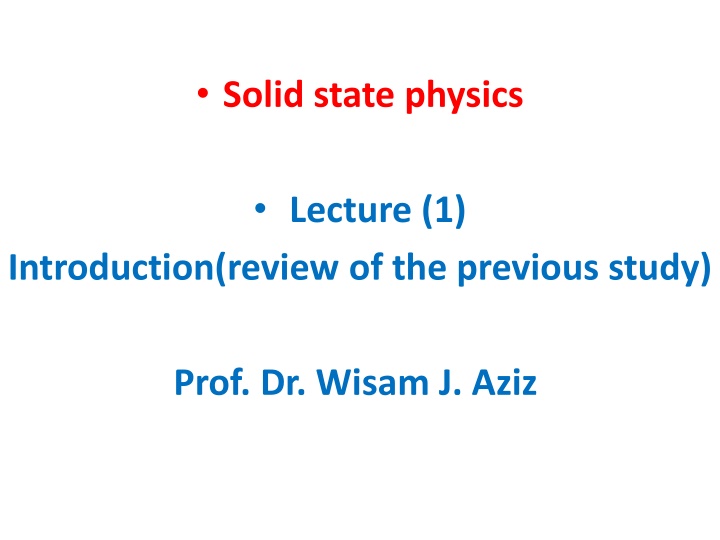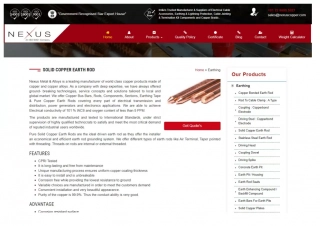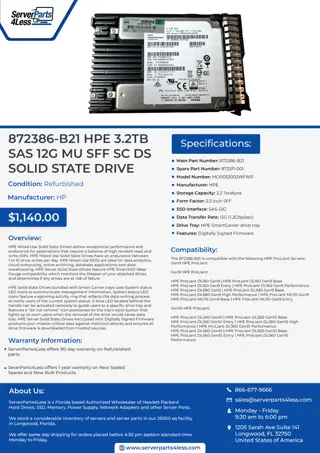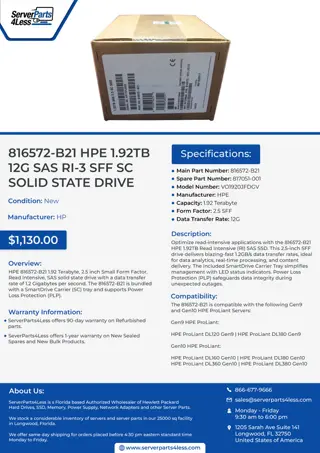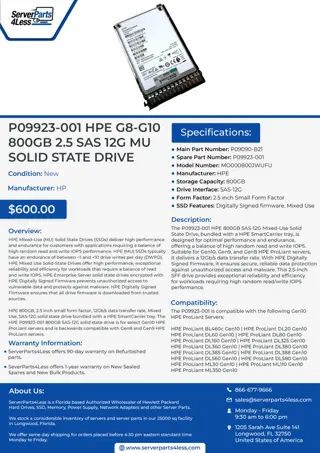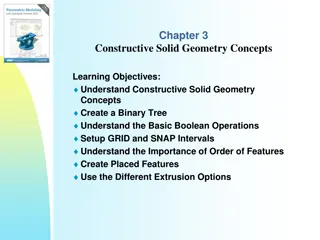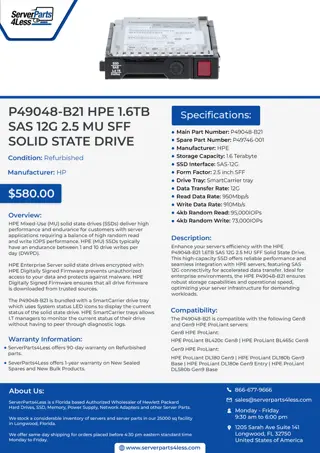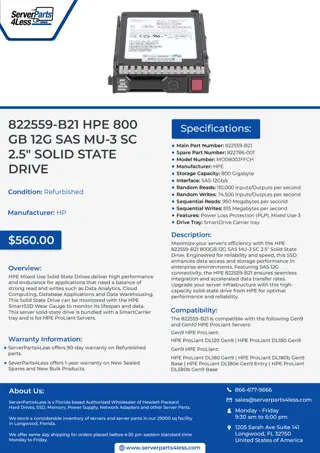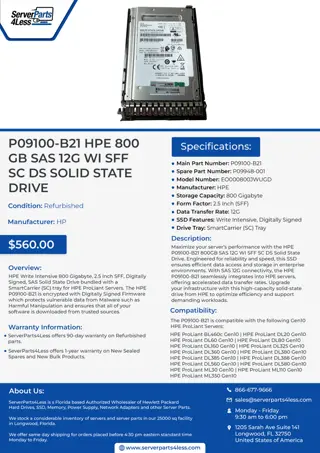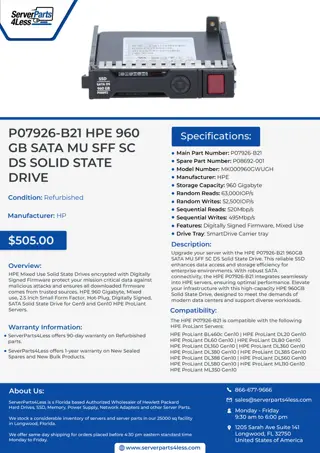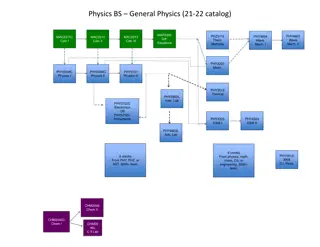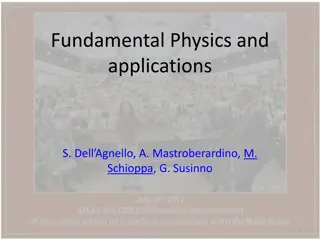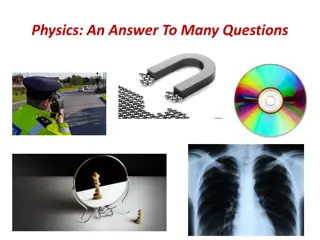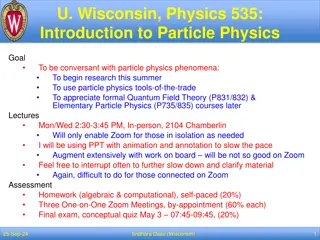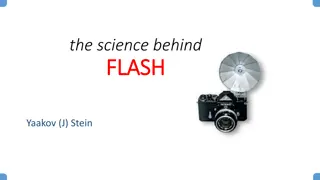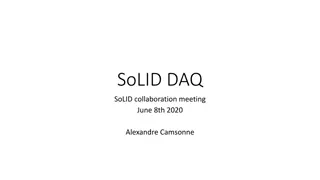Introduction to Solid State Physics
This lecture covers the fundamentals of crystalline structures, types of crystals, methods to determine crystal structures, properties of crystal structures, and unit cells in solid state physics. Topics include crystalline vs non-crystalline structures, X-ray diffraction, electron diffraction, neutron diffraction, crystal systems, Miller indices, and crystalline defects.
Download Presentation

Please find below an Image/Link to download the presentation.
The content on the website is provided AS IS for your information and personal use only. It may not be sold, licensed, or shared on other websites without obtaining consent from the author.If you encounter any issues during the download, it is possible that the publisher has removed the file from their server.
You are allowed to download the files provided on this website for personal or commercial use, subject to the condition that they are used lawfully. All files are the property of their respective owners.
The content on the website is provided AS IS for your information and personal use only. It may not be sold, licensed, or shared on other websites without obtaining consent from the author.
E N D
Presentation Transcript
Solid state physics Lecture (1) Introduction(review of the previous study) Prof. Dr. Wisam J. Aziz
Contents 1- Type of Crystalline Structure 2- Methods to determine the crystal structure 3- Properties of crystal structure 4- Braves lattices. 5- Types of crystal systems. 12- Miller indices. 13- Types of crystalline defects
Type of Crystals Structure :- 1- Crystalline Structure:- It is a group of atoms that occur and organized periodically in a three-dimensional system. Their bonds are non-cracking and have long-Range System such as diamonds, food salt, sulfur and copper. 2 - Random (non crystalline ) structure: It is a group of atoms whose distribution is random and irregular. Its structure is like a liquid and its bonds are easily cracked. They are subject to a short-Range system and their structure is almost stable. Constant temperature such as .rubber, wax, plastic and glass -
Methods to determine the crystal structure: - 1- X-ray diffraction. 2- Electrons diffraction. 3- Neutrons diffraction. There are three cases of crystallization Single crystal A crystal in which the arrangement of atoms in a long and frequent in the material such as iron. Polycrystal It is a repetition of the monocrystalline crystalline or resulting from the powder and grinding of the monocrystalline crystal. The powder mass is considered as poly crystalline, such as crystalline salt. Amorphous In this type the material is arrangement away from the crystalline organization and does not have to do with crystalline structure. - :
Properties of crystal structure :- The most important characteristics of the crystalline structure are a, b, c axes Beta, Alpha, Kama angles, The size of these cells is called the coordinate of the crystalline Structure. Shape variables of the unit cell
The Unit Cell :- It is the simplest and smallest geometric form that can be repeated to obtain the crystalline lattice There are two types of unit cell :- 1. Primitive cell 2. Non- Primitive cell That the Primitive transition vectors have one piping point per cell unit and have the same structure and direction. Non- Primitive transport vectors have more than one transmission point per cell unit.
Lattice symmetry operation:- 1. Transitional symmetry. 2. Rotational symmetry. 3. Reflective symmetry. 4. Inversion symmetry. 5. Glide symmetry. 6. Screw symmetry. Crystalline Systems: - The crystalline system represents two processes of rotational symmetry and reflective symmetry, classified into seven systems (cube, Tetragonal, hexagonal, triangular, monoclinic, triclinic ,Orthorhombic) Braves lattices:- This is called the world name Braves, which is 14 lattice, and varies according to the crystalline structures, and made these alloys of different metals to obtain the regular grid crystalline classification to seven systems and arranged atoms in a three-dimensional system.
- : 1-Cubic System In science metals is a system of crystallization of metals. It is found practical that the salts and metals crystallize according to one of the seven crystallization systems. This system has all its angles ( = =y= 90 ) and its letters are equal a = b = c where: a, b, c are the lengths of the crystalline axes, Crystalline example of cubic NaCl. Discuss a, b, c and angles between these axes , ,y, so that they are returned to the seven crystalline systems.
Shape of Cubic System SC BCC FCC
1 - The simple cubic: - It is a rare cube in nature because it does not exploit the cell's vacuum optimally, for example, we find it in the crystallization of polonium. The point is that the single cell represents only one point, representing (1/8) points from each of the eight angles. Characteristics of the simple cubic: - Number of points for cell unit 1. Closest Neighborhood 6. The closest distance is R = a / 2. Total cell size (a ^ 3) Fill factor = (cubic size * number of atoms / total cell volume) Fill factor = 52%. SC .
2-cubic center body: - This type of cell contains one atom in the center of the cube as well as the presence of eight atoms at the corners of the cube common with primitive cells such as the cube-centered sodium chloride salts. The properties of the cube are centered on the body Number of points for cell unit 2. The nearest neighborhood 8. The nearest distance is r = (a / 4)root3. . Fill factor = 68% BCC
3-Face Center Cubic:- It is a cube with eight atoms in the eight corners of the cube, as well as six atoms in the center of each of the six facades of the cube (points at the eight corners and points at the center of each of the six faces). This is characterized by the simple cube and since each face is a joint between two cells, this means that the share of the cell of these six points is three points to be a total of what represents the cell is four points, for example, the cube is located in the faces of cesium chloride CsCl). Characteristics of FCC Number of points in unit cell is 4. Nearest neighborhood = 12. The distance closest r = root2 (a / 4). Filling Factor = 74% FCC
2-Tetragonal System:- It is a quadruple, with a square base and a square shape. Its axes are a = b, not equal to c, and all angles are equal to 90 degrees. Its sides are rectangular, equal to the length of one side. Simple Tetragonal System. The Tetragonal system is centered. Examples of the Tetragonal system are titanium dioxide (TiO2), zirconium (Zr).
3-Hexagonal System :- Is a publication whose base list is shaped by a hexagon, equilateral. It has the advantage This system has its angles, y= 120, 90 = = and its characters (a = b c). Shape Hexagonal system Examples of hexagonal system (Zincate - quartz - Magnesia_ graphite)
4 -Trigonal System:- The system is a three-sided system (also called a system similar to an integer). This system is similar in shape to a cube with a slanted face on one side, and its letters (a = b = c) are equal angles, but are not present ( = = y 90). Shape Trigonal System Examples of this system (Calcite - aluminum oxide - bismuth).
5-Orthorhombic System :- This system has all its angles ( = = y = 90) andits characters are completely different (a b c). Form of the system Examples of this system (Parate, bromine , sulfate)
6-Monoclinic System:- This system has four rectangular faces and two parallel sides, and has Two angles and the third non-existent ( = y = 90, 90) and the letters are not equal a b c). Shape Monolithic system Examples of this system (Sodium Hydroxylate - Potassium Chlorate - Lead Chromates).
7-Triclinic System:- All angles of this system are unequal and non-existent (90 y ) and its characters are not equal (a b c). Shape Triclinic system Examples of this system (water copper , Axcinite).
The crystalline levels and coefficients of Miller: - Crystals consist of atomic levels and each level has a position and direction within the crystal. Indices Miller:- Is a descriptive mathematical method for the orientation of the crystalline or crystalline levels within the crystalline grid connected to the unit cell created by the world. This method is not dependent on the solid angles of the crystal, but is based on three symbols (h, k, L) With Miller's coefficients. These coefficients are useful for understanding many phenomena in materials science, especially single crystals, and the structure of micro-structure of materials through the use of X-ray diffraction and crystalline defects and movement which determine the mechanical properties of materials.
- The representation of Miller's transactions is summarized as follows: 1 - we define the values of the three axes( z, y, x) 2 - take inverted the values of those axes. 3 - We find the new values and put them in small brackets without putting the vowel between the values of transactions agencies () to represent the level of the decree. IMPORTANT NOTE / If the value of one of the axes is negative, move the center of cubic to direction value the negative .
Crystal Defects:- It is known that solid mineral matter is crystalline material, that is, its atoms are placed in regular grid structures called crystalline structures (other materials such as wax and glass are called amorphous materials because their atoms are randomly placed). But in reality there is no perfect crystallization. Crystal defects are related to several factors, such as increasing temperature. Disadvantages do not mean they are necessarily bad. In fact, we often resort to creating defects in the crystal structure in different ways to improve the physical or mechanical properties of the material.
Type Crystal defects :- 1-point defects :- a- schottky defect. b- Frenked defect. 2-Line defects :- a- Edge dislocation. b- screw dislocation. 3-Surface defects:- a- External surface. b- Grain boundaries.
SOURCES 1-SOILD BODY PHSICS BOOK. 2-INTRODUCTION TO SOILD STATE ,CHARLES KITTEL. 3- SOILD STATE PHYSICS, BLAKMORE
